The Effect of Direct Quenching on the Microstructure and Mechanical Properties of NiCrMo and Cu-Bearing High-Strength Steels
Abstract
:1. Introduction
2. Experimental Procedures
2.1. Experimental Steel
2.2. Characterization
3. Results
3.1. Mechanical Properties
3.2. Microstructures
3.3. Precipitation Behavior during Tempering
4. Discussion
4.1. The Common Effect of DQ on NiCrMo and Cu-Bearing Steels
4.2. The Different Effect of DQ on NiCrMo and Cu-Bearing Steels
5. Conclusions
- (1)
- Through controlled rolling and direct quenching, grain refinement and an increase in the dislocation density were observed in both NiCrMo-DQ and Cu-DQ steels. Equiaxed grains were observed in RQ steels, while deformed and elongated grains were observed in DQ steels.
- (2)
- After appropriate tempering, NiCroMo steels exhibited a tempered martensite microstructure, whereas Cu-bearing steels exhibited a bainite microstructure. For Cu-DQT steels, the precipitation behavior of Cu particles and alloy carbides was promoted by grain refinement and the high-density dislocation during tempering.
- (3)
- NiCrMo-DQT steels achieved high strength through grain refinement strengthening and dislocation strengthening and exhibited a yield strength of 809 MPa (106 MPa higher than NiCrMo-RQT steels), with an impact energy of 237 J at −84 °C. Cu-DQT steels achieved high strength through grain refinement strengthening, dislocation strengthening, and precipitation strengthening and exhibited a yield strength of 805 MPa (159 MPa higher than Cu-RQT steels), with an impact energy of 248 J at −84 °C.
Author Contributions
Funding
Data Availability Statement
Conflicts of Interest
References
- Wu, C.; Han, S. Hot Deformation Behavior and Dynamic Recrystallization Characteristics in a Low-Alloy High-Strength Ni–Cr–Mo–V Steel. Acta Metall. Sin. (Engl. Lett.) 2018, 31, 963–974. [Google Scholar] [CrossRef]
- Czyryca, E.J.; Link, R.E.; Wong, R.J.; Aylor, D.A.; Montem, T.W.; Gudas, J.P. Development and certification of HSLA -100 steel for naval ship construction. Nav. Eng. J. 1990, 102, 63–82. [Google Scholar] [CrossRef]
- Jain, D.; Isheim, D.; Seidman, D.N. Carbon redistribution and carbide precipitation in a high-strength low-carbon HSLA-115 steel studied on a nanoscale by atom probe tomography. Metall. Mater. Trans. 2017, 48, 3205–3219. [Google Scholar] [CrossRef]
- Jain, D.; Isheim, D.; Hunter, A.H.; Seidman, D.N. Multicomponent high-strength low-alloy steel precipitation-strengthened by sub-nanometric Cu precipitates and M2C carbides. Metall. Mater. Trans. 2016, 47, 3860–3872. [Google Scholar] [CrossRef]
- Mandal, G.; Ghosh, S.K.; Chakrabarti, D.; Chatterjee, S. Influence of TMCP parameters on structure and properties of low carbon Cu bearing ultra-high strength steel. Phys. Met. Metallogr. 2020, 121, 269–275. [Google Scholar] [CrossRef]
- Fu, W.; Li, C.; Di, X.; Fu, K.; Gao, H.; Fang, C.; Lou, S.; Wang, D. Refinement mechanism of nanoscale Cu-rich precipitates by Mo addition and its effect on strength toughness of Cu-bearing low carbon high strength steel. Mater. Sci. Eng. A 2022, 849, 143469. [Google Scholar] [CrossRef]
- Li, C.; Duan, R.; Fu, W.; Gao, H.; Wang, D.; Di, X. Improvement of mechanical properties for low carbon ultra-high strength steel strengthened by Cu-rich multistructured precipitation via modification to bainite. Mater. Sci. Eng. A 2021, 817, 141337. [Google Scholar] [CrossRef]
- Dong, X.X.; Shen, Y.F.; Yin, T.W.; Misra, R.D.K.; Lin, G. Strengthening a medium carbon steel to 2800 MPa by tailoring nanosized precipitates and the phase ratio. Mater. Sci. Eng. A 2019, 759, 725–735. [Google Scholar] [CrossRef]
- Saha, A.; Olson, G.B. Computer-aided design of transformation toughened blast resistant naval hull steels: Part I. J. Comput. Aided Mater. Des. 2007, 14, 177–200. [Google Scholar] [CrossRef]
- Saha, A.; Jung, J.; Olson, G.B. Prototype evaluation of transformation toughened blast resistant naval hull steels: Part II. J. Comput. Aided Mater. Des. 2007, 14, 201–233. [Google Scholar] [CrossRef]
- Bono, J.T.; DuPont, J.N.; Jain, D.; Baik, S.I.; Seidman, D.N. Investigation of strength recovery in welds of NUCu-140 steel through multipass welding and isothermal post-weld heat treatments. Metall. Mater. Trans. 2015, 46, 5158–5170. [Google Scholar] [CrossRef]
- Ghafouri, M.; Afkhami, S.; Pokka, A.P.; Javaheri, V.; Togiani, A.; Larkiola, J.; Björk, T. Effect of temperature on the plastic flow and strain hardening of direct-quenched ultra-high strength steel S960MC. Thin Walled Struct. 2024, 194, 111319. [Google Scholar] [CrossRef]
- Kumar, G.; Ghosh, S.; Pallaspuro, S.; Somani, M.C.; Kömi, J.; Mishra, S.K.; Gokhale, A.A. Fracture toughness characteristics of thermo-mechanically rolled direct quenched and partitioned steels. Mater. Sci. Eng. A 2022, 840, 142788. [Google Scholar] [CrossRef]
- Hannula, J.; Kaijalainen, A.; Porter, D.A.; Somani, M.C.; Kömi, J. Evaluation of Mechanical Properties and Microstructures of Direct-Quenched and Direct-Quenched and Tempered Microalloyed Ultrahigh-Strength Steels. Steel Res. Int. 2020, 92, 2000451. [Google Scholar] [CrossRef]
- Wang, H.S.; Kang, J.; Dou, W.X.; Zhang, Y.X.; Yuan, G.; Cao, G.M.; Misra, R.D.K.; Wang, G.D. Microstructure and mechanical properties of hot-rolled and heat-treated TRIP steel with direct quenching process. Mater. Sci. Eng. A 2017, 702, 350–359. [Google Scholar] [CrossRef]
- Wang, H.; Liu, D.; Wang, J.; Yang, Y.; Wang, H.; Lv, N.; Nan, J. Simultaneous increase of ultimate tensile strength and uniform elongation of 30Si2MnCrMoVE ultra-high strength steel by hot deformation direct quenching and partitioning. J. Mater. Res. Technol. 2022, 19, 404–417. [Google Scholar] [CrossRef]
- Saastamoinen, A.; Kaijalainen, A.; Nyo, T.T.; Suikkanen, P.; Porter, D.; Kömi, J. Direct-quenched and tempered low-C high-strength structural steel: The role of chemical composition on microstructure and mechanical properties. Mater. Sci. Eng. A 2019, 760, 346–358. [Google Scholar] [CrossRef]
- Xie, Z.J.; Shang, C.J.; Wang, X.L.; Ma, X.P.; Subramanian, S.V.; Misra RD, K. Microstructure-property relationship in a low carbon Nb-B bearing ultrahigh strength steel by direct-quenching and tempering. Mater. Sci. Eng. A 2018, 727, 200–207. [Google Scholar] [CrossRef]
- Ghosh, S.; Kaikkonen, P.; Javaheri, V.; Kaijalainen, A.; Miettunen, I.; Somani, M.; Kömi, J.; Pallaspuro, S. Design of tough, ductile direct quenched and partitioned advanced high-strength steel with tailored silicon content. J. Mater. Res. Technol. 2022, 17, 1390–1407. [Google Scholar] [CrossRef]
- Dhua, S.K.; Sen, S.K. Effect of direct quenching on the microstructure and mechanical properties of the lean-chemistry HSLA-100 steel plates. Mater. Sci. Eng. A 2011, 528, 6356–6365. [Google Scholar] [CrossRef]
- Ungár, T.; Ott, S.; Sanders, P.G.; Borbély, A.; Weertman, J.R. Dislocations, grain size and planar faults in nanostructured copper determined by high resolution X-ray diffraction and a new procedure of peak profile analysis. Acta Mater. 1998, 46, 3693–3699. [Google Scholar] [CrossRef]
- Yong, L. Second Phases in Structural Steels; Metallurgical Industry Press: Beijing, China, 2006. [Google Scholar]
- Saastamoinen, A.; Kaijalainen, A.; Porter, D.; Suikkanen, P.; Yang, J.R.; Tsai, Y.T. The effect of finish rolling temperature and tempering on the microstructure, mechanical properties and dislocation density of direct-quenched steel. Mater. Charact. 2018, 139, 1–10. [Google Scholar] [CrossRef]
- Hu, L.; Zhao, S.J.; Liu, Q. The effect of size of Cu precipitation on the mechanical properties of microalloyed steel. Mater. Sci. Eng. A 2012, 556, 140–146. [Google Scholar] [CrossRef]
- Mulholland, M.D.; Seidman, D.N. Nanoscale co-precipitation and mechanical properties of a high-strength low-carbon steel. Acta Mater. 2011, 59, 1881–1897. [Google Scholar] [CrossRef]
- Tiemens, B.L.; Sachdev, A.K.; Olson, G.B. Cu-precipitation strengthening in ultrahigh-strength carburizing steels. Metall. Mater. Trans. 2012, 43, 3615–3625. [Google Scholar] [CrossRef]
- Tiemens, B.L.; Sachdev, A.K.; Mishra, R.K.; Olson, G.B. Three-dimensional (3-D) atom probe tomography of a Cu-Precipitation-Strengthened, ultrahigh-strength carburized steel. Metall. Mater. Trans. 2012, 43, 3626–3635. [Google Scholar] [CrossRef]
- Kan, L.; Ye, Q.; Wang, Z.; Zhao, T. Improvement of strength and toughness of 1 GPa Cu-bearing HSLA steel by direct quenching. Mater. Sci. Eng. A 2022, 855, 143875. [Google Scholar] [CrossRef]
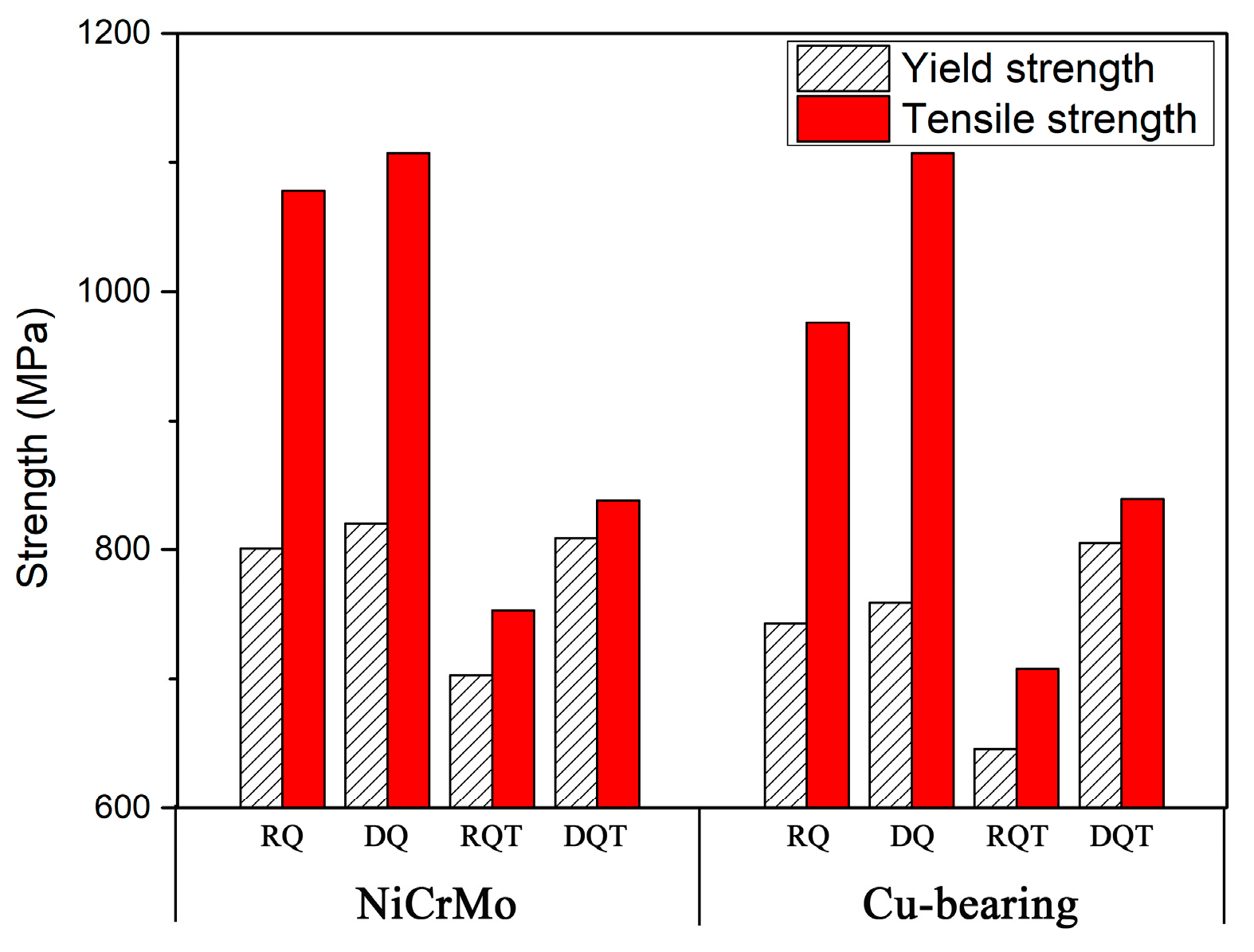
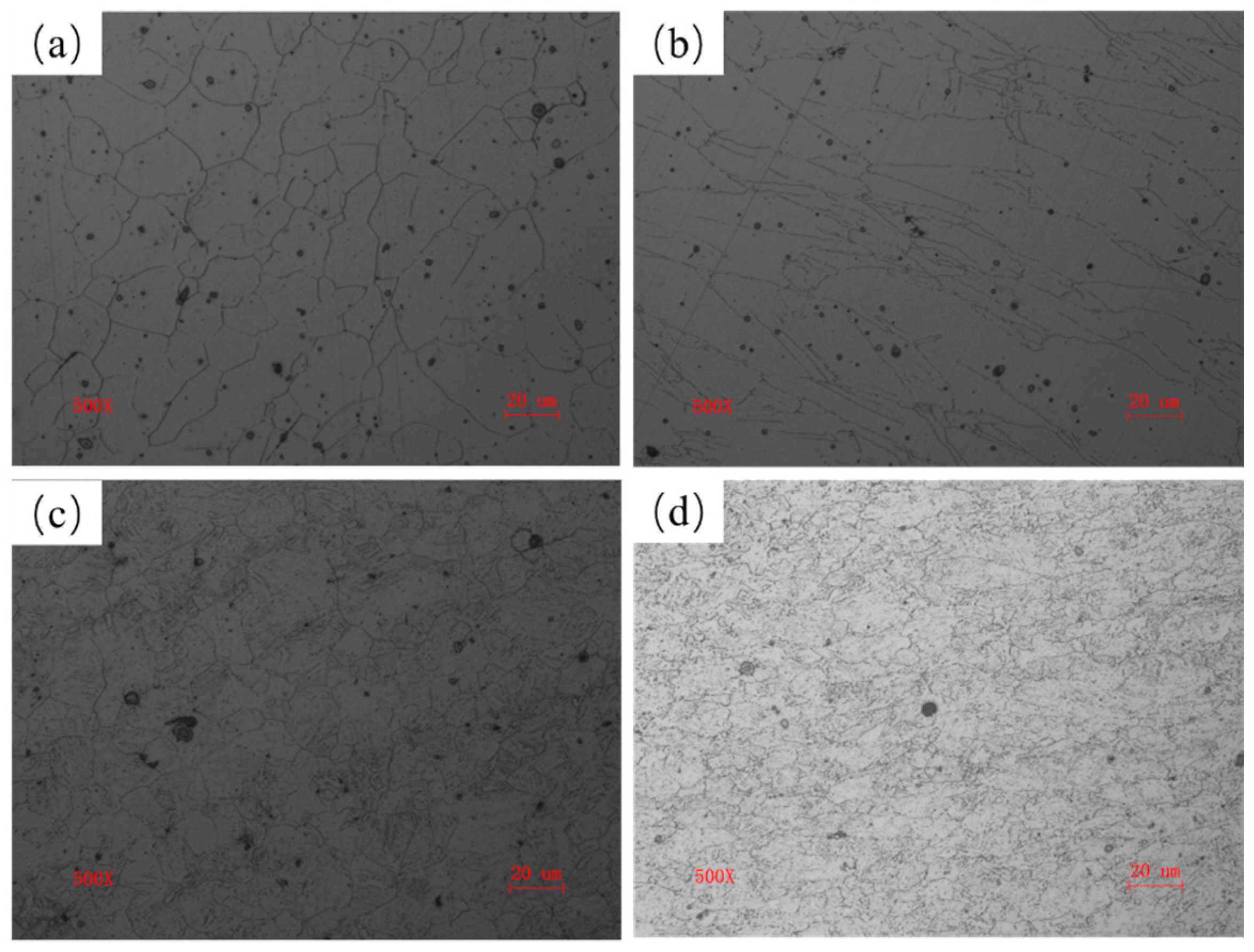
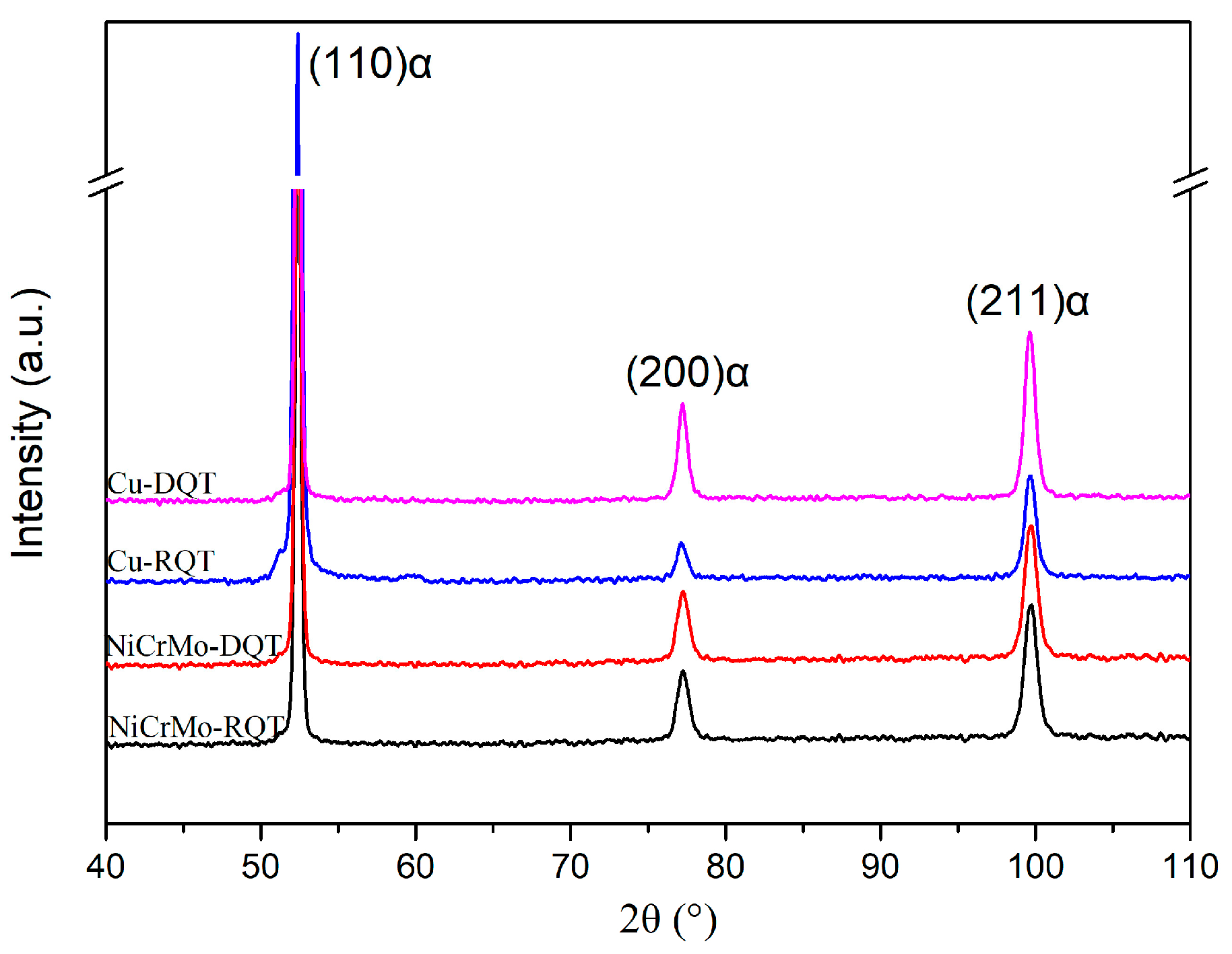
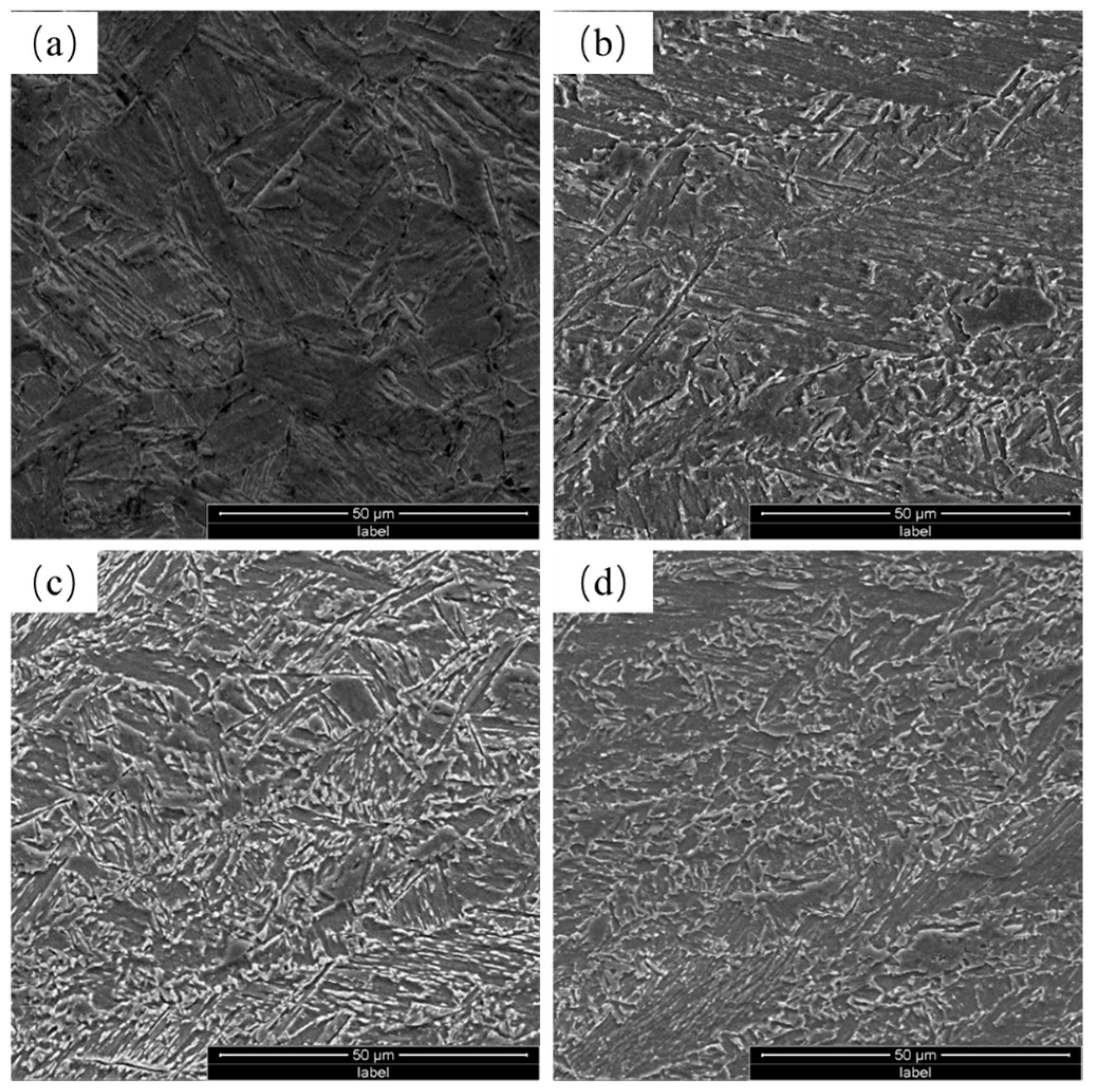

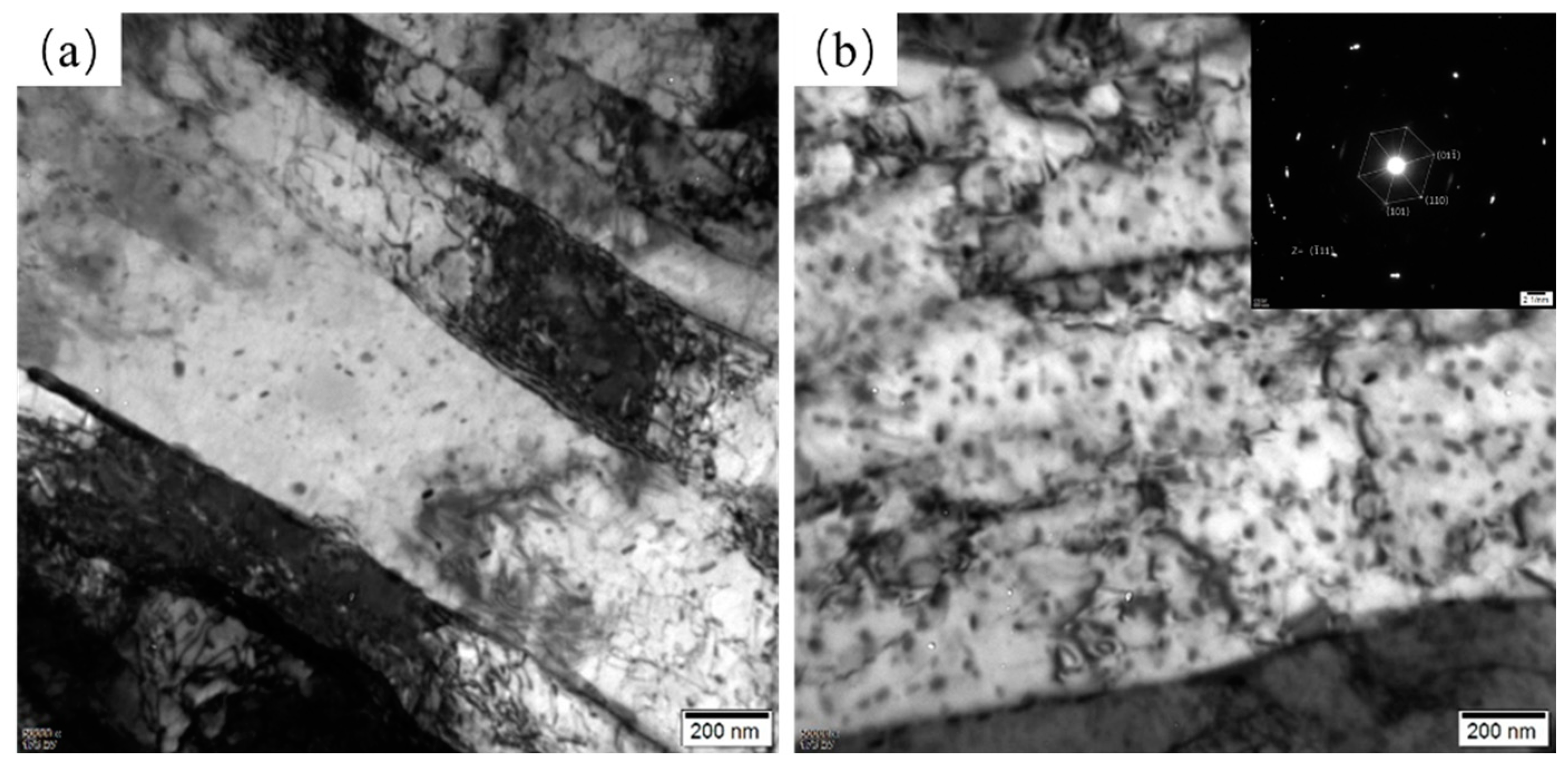
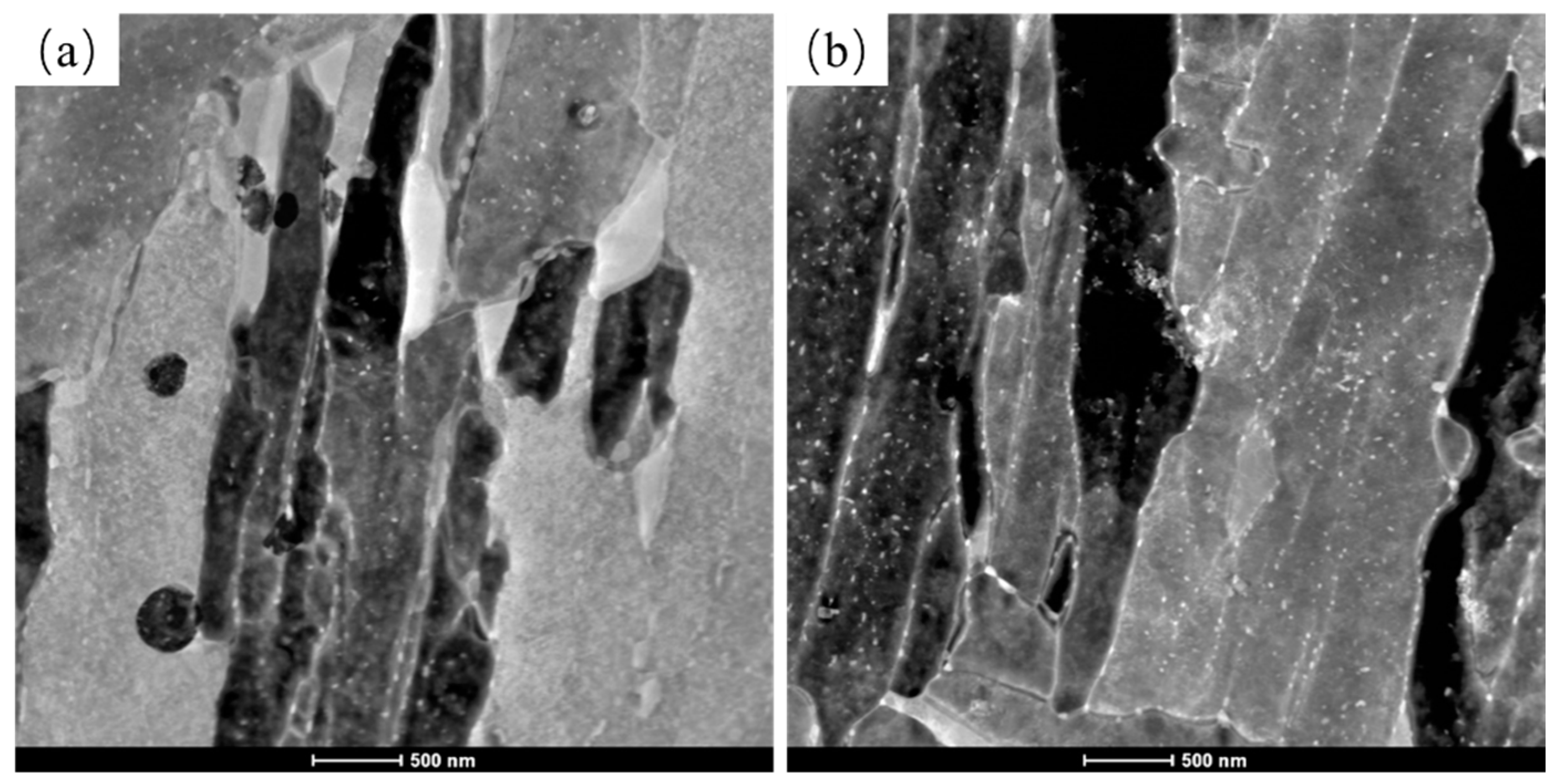
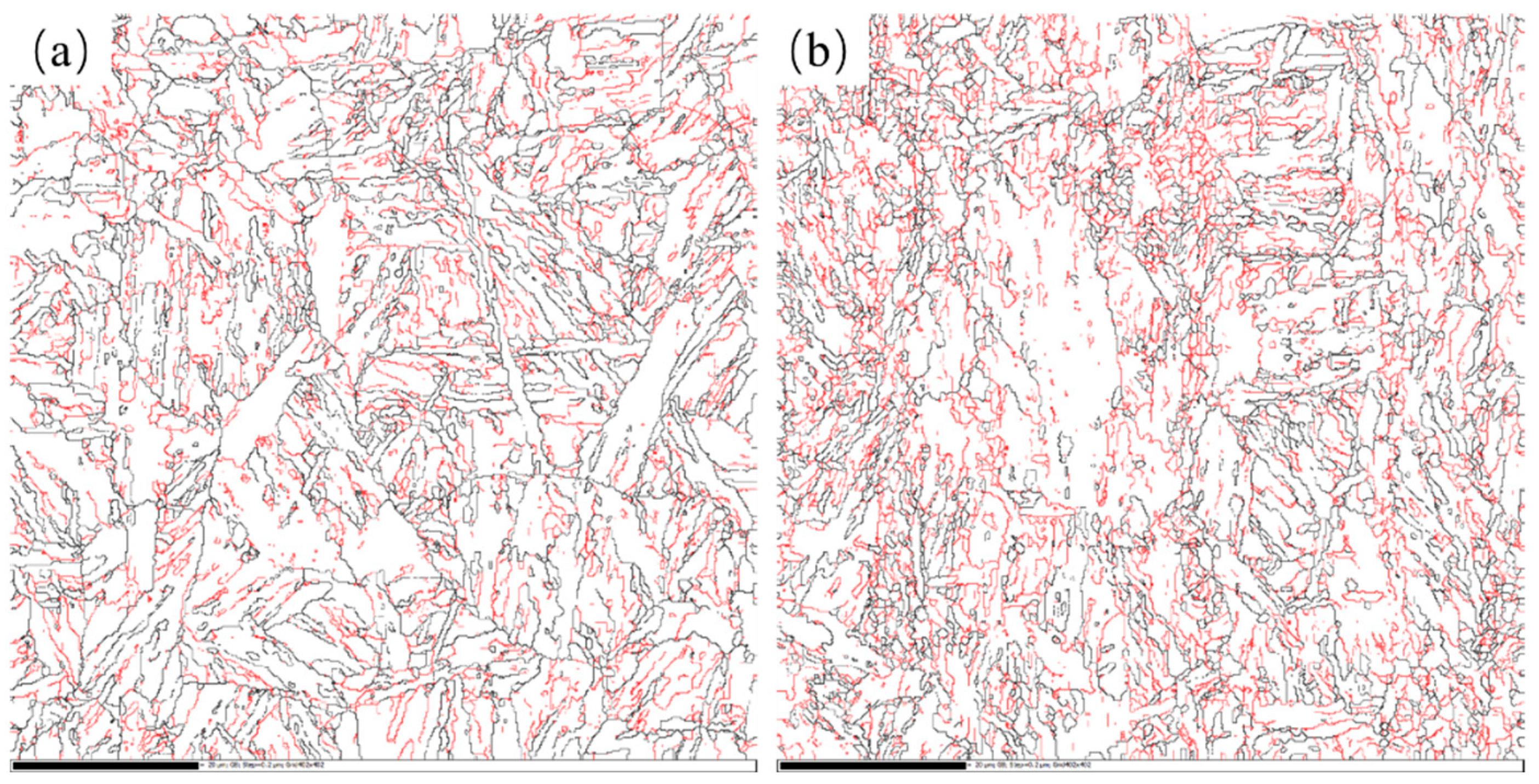
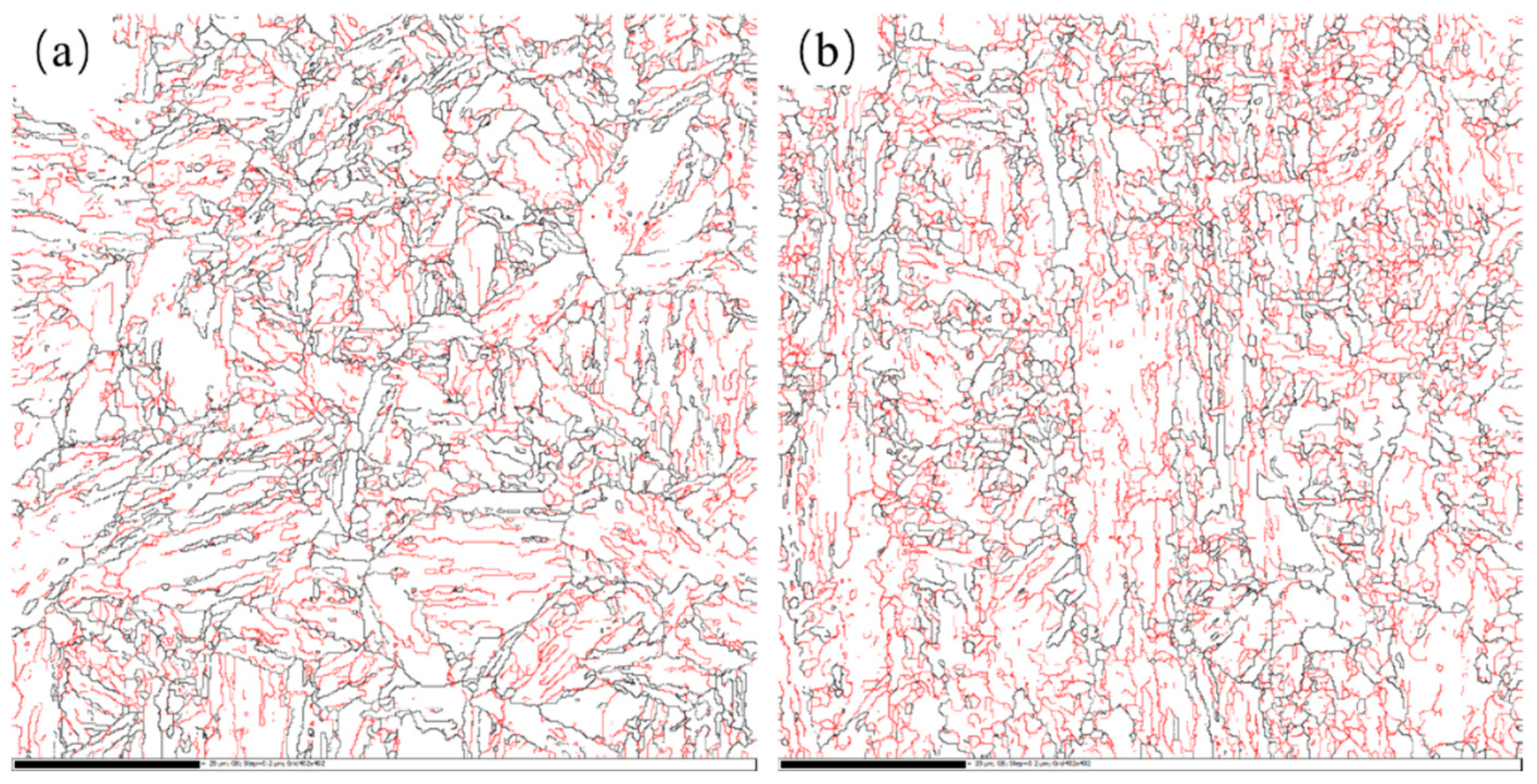
| C | Si | Mn | Ni | Cr | Mo | V | Cu | Nb | Ti | |
|---|---|---|---|---|---|---|---|---|---|---|
| NiCrMo | 0.08 | 0.25 | 0.50 | 2.70 | 1.00 | 0.20 | 0.07 | |||
| Cu-bearing | 0.04 | 0.25 | 0.60 | 2.40 | 0.60 | 0.35 | 1.50 | 0.03 | 0.02 |
| Yield Strength (MPa) | Tensile Strength (MPa) | Elongation (%) | −84 °C CVN (J) | |
|---|---|---|---|---|
| NiCrMo-RQ | 801 | 1078 | 19 | 196 |
| NiCrMo-DQ | 820 | 1107 | 16 | 199 |
| NiCrMo-RQT | 703 | 753 | 23 | 239 |
| NiCrMo-DQT | 809 | 838 | 20 | 237 |
| Cu-RQ | 743 | 976 | 16 | 221 |
| Cu-DQ | 759 | 1007 | 16 | 193 |
| Cu-RQT | 646 | 708 | 25 | 262 |
| Cu-DQT | 805 | 839 | 20 | 248 |
| M3C | MC | ||||||||||||
|---|---|---|---|---|---|---|---|---|---|---|---|---|---|
| Fe | Mn | Cr | Mo | Ni | C* | Σ | Mo | Nb | Ti | V | C* | Σ | |
| NiCrMo-RQT | 0.577 | 0.028 | 0.161 | 0.010 | 0.0056 | 0.057 | 0.838 | 0.010 | / | / | 0.042 | 0.011 | 0.063 |
| NiCrMo-DQT | 0.577 | 0.028 | 0.158 | 0.011 | 0.0059 | 0.056 | 0.836 | 0.011 | / | / | 0.043 | 0.011 | 0.066 |
| Cu-RQT | 0.302 | 0.016 | 0.052 | 0.011 | 0.0042 | 0.028 | 0.413 | 0.011 | 0.025 | 0.016 | / | 0.0086 | 0.061 |
| Cu-DQT | 0.333 | 0.019 | 0.056 | 0.012 | 0.0033 | 0.030 | 0.454 | 0.012 | 0.027 | 0.016 | / | 0.0090 | 0.064 |
Disclaimer/Publisher’s Note: The statements, opinions and data contained in all publications are solely those of the individual author(s) and contributor(s) and not of MDPI and/or the editor(s). MDPI and/or the editor(s) disclaim responsibility for any injury to people or property resulting from any ideas, methods, instructions or products referred to in the content. |
© 2024 by the authors. Licensee MDPI, Basel, Switzerland. This article is an open access article distributed under the terms and conditions of the Creative Commons Attribution (CC BY) license (https://creativecommons.org/licenses/by/4.0/).
Share and Cite
Zhou, N.; Chai, F.; Luo, X.; Wang, W.; Gao, F. The Effect of Direct Quenching on the Microstructure and Mechanical Properties of NiCrMo and Cu-Bearing High-Strength Steels. Materials 2024, 17, 1397. https://doi.org/10.3390/ma17061397
Zhou N, Chai F, Luo X, Wang W, Gao F. The Effect of Direct Quenching on the Microstructure and Mechanical Properties of NiCrMo and Cu-Bearing High-Strength Steels. Materials. 2024; 17(6):1397. https://doi.org/10.3390/ma17061397
Chicago/Turabian StyleZhou, Naipeng, Feng Chai, Xiaobing Luo, Weiyi Wang, and Feng Gao. 2024. "The Effect of Direct Quenching on the Microstructure and Mechanical Properties of NiCrMo and Cu-Bearing High-Strength Steels" Materials 17, no. 6: 1397. https://doi.org/10.3390/ma17061397




